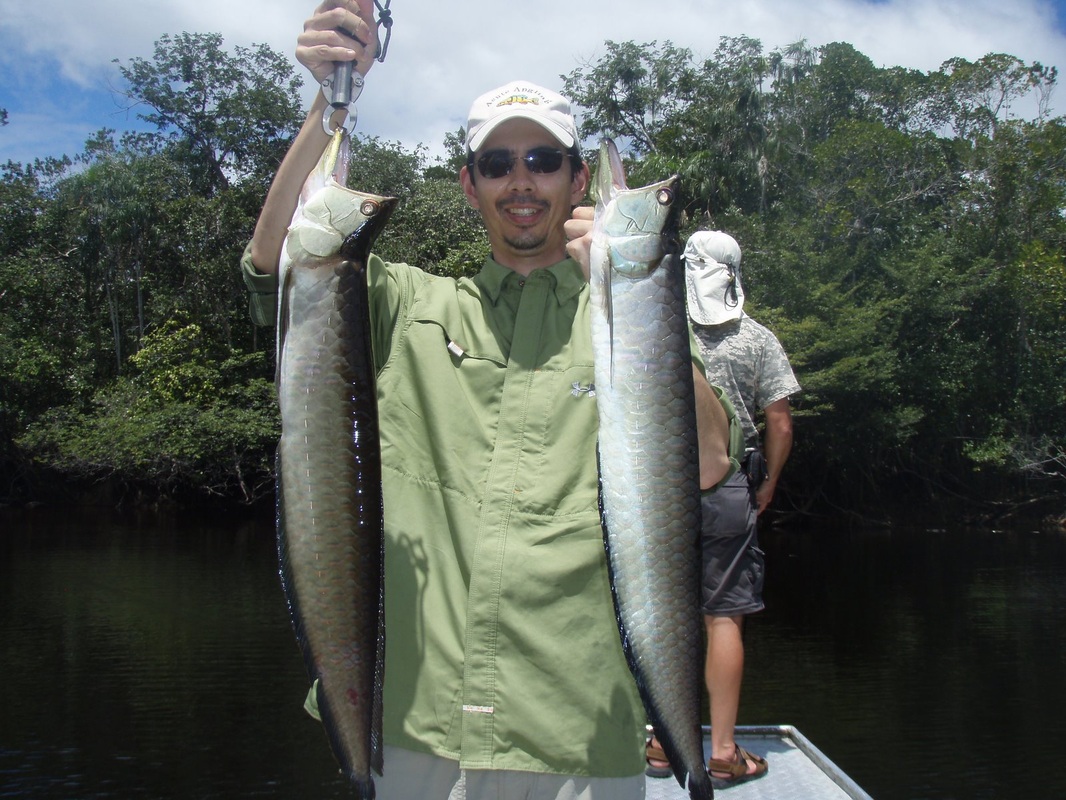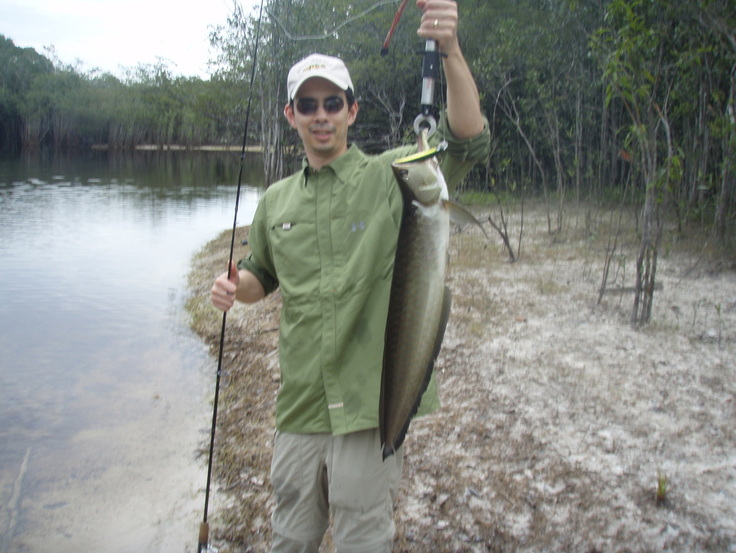| Freshwater Aquarium Fish_Arowana This page will give a completely detailed profile of the selected fish, from A to Z. The profiled fish will be chosen randomly by Badman, and will come from the complete genre of tropical fish. New profiles are added on a regular basis. If you would like to submit a profile for the site please contact me. Don't forget to let us know you experiences with this fish by filling out the  
Osteoglossum bicirrhossum
| |||||||||||||||||||||||
Overview:
Image gallery: Discuss: Distribution
General Body Form:
Coloration:
 Osteoglossum ferreirai Black Arowana Maintenance:
 Silver Arowana juveniles Biotope:
Breeding:
 | |||||||||||||||||||||||
Freshwater Aquarium Fish
Thứ Ba, 26 tháng 5, 2015
Freshwater Aquarium Fish_Arowana
Arowana Fishing - How To Catch Any Fish
Arowana (South American)
Osteoglossum bicirrhosum
Osteoglossum ferreirai
Arowana DescriptionArowanas are a family of long bony fishes found throughout the world. There are several species but this page will focus on the two found in South America - the Silver Arowana and the Black Arowana. They are similar in appearance and both reach over three feet in length. The Silvers grow a little faster than the Blacks but they have similar diets and habits. They are found in the Amazon and its tributaries. They are popular in the aquarium trade and are a relatively hardy and easy to keep fish if you have a large enough tank. See below for a pic of one I had in an aquarium for a few years.
Arowanas are surface oriented fish with eyes near the tops of their heads and they feed on things near the surface of the water. On occasion they will even leap out of the water to snatch small birds and insects. Their diet consists of smaller fish, insects, birds, and basically any other small creature that swims by and fits in their mouths.
Arowanas are generally caught as by catch by fishermen fishing for Peacock Bass. When hooked they put up a spirited fight for their size, generally leaping out of the water multiple times. They have tiny raspy teeth that won't easily bite through your line. Despite their large scales and bony appearance they are actually quite tasty.
Arowana TackleWhen fishing for Arowanas you can use fairly light spinning or baitcast tackle but since they generally live near other larger species like Peacock Bass you probably wouldn't want to. I like to fish with a 25lb fluorocarbon leader but I'm not sure it's necessary. I like the peace of mind of greater abrasion resistence though. Great reels for these are the Daiwa Steez and Daiwa Certate. recommendations.
Arowana Techniques
Arowanas are caught on both lures and bait, although in the Amazon they are primarily fished with lures. They can often be seen at the surface under the cover of overhanging trees and bushes.
Arowana LuresBecause of their surface orientation, small poppers work well. Shallow running jerkbaits such as the Yo-Zuri Crystal Minnow also work well when fished erratically. Arowanas are not shy and will generally attack most lures that resemble small fish and are twitched in front of their faces.
Arowana BaitsI have not done any bait fishing for Arowana. Small fish probably work well.
Where to get the big ArowanaThe Amazon river tributaries are where you get the big ones. The main river does not have a good fishery and many of the tributaries do not either. The best fisheries are generally slow-moving "blackwater" tributaries. You get a very short window in most areas to fish; usually just a few weeks per year. Most of the year the water level is too high and the water extends into the jungle. The fish head in there and become very spread out and very hard to catch. A good operator will cancel a trip at this point rather than let anglers suffer through poor fishing. The dry season concentrates the fish in a smaller area and makes them much easier to target. However, the dry season can (and nearly always does) vary from year to year in a particular area and rains during the dry season can raise water levels and make fishing tough. This fishery is tough to time but when you do it right it's amazing.
The Amazon fisheries are generally accessed in one of three ways: fixed lodge, mothership, or floating tents/camping. The fixed lodges can offer good fishing but if water levels are off, which they often are, you could be stuck catching few if any fish. Motherships offer more mobility to go where water levels are optimal, although in very dry conditions they may not be able to access all areas. Floating tents/camping offers the most mobility and therefore the best shot at hitting things at the right time. If the fishing is not good, you can move. There is really no way to fish these remote areas on the cheap as many are in restricted Indian reservations and you could be in serious trouble if you just tried to go in there on your own.
In general, the closer to the headwaters you get the less water fluctuation there is.
Guyana is supposed to have a good Arowana fishery but it is not a very developed destination.
Other Arowana Resources
If you want to catch any species in the Amazon, I recommend these guys: ey are reputable and their site has a wealth of information on Arowanas, Peacock Bass and other Amazon species.
Freshwater Aquarium Fish_Arowana information types feeding and care
Freshwater Aquarium Fish_Arowana information types feeding and care
If you'd like to do something a little different with your aquarium there are few fish more exotic than arowanas. Also known as dragonfish and bony tongues, they have traditionally been associated with dragons and thought to bring good luck and wealth.
Considering their striking appearance, with elegantly delineated scales and impressive barbels, it's easy to see why. Many arowana breeders participate in shows and competitions to celebrate the beauty of their fish.
Because of their aggressive temperament they should not be kept with fish much smaller than themselves, but they can get along well in community tanks with fish like cichlids, oscars and plecos.
They are sensitive to water condition, so you'll need good filtration. They also have a tendency to jump, so you'll need a secure aquarium hood.
Types of Arowanas
There are several species of arowana, originating from South America, Africa, Australia and Asia.Asian arowanas tend to be the most highly prized, but they are an endangered species and it is illegal to trade them in unless they are over thirty years old or captive bred (in which case they are marked with microchips).
- Silver Arowanas - These are the most common choice for aquarium hobbyists, but they are also the largest, sometimes growing to four feet in length.
- Black Arowanas -Almost identical to silver arowanas but for their colour, these fish are slightly less hardy.
- Australian Arowanas -These look very similar to their Asian equivalents but are far less expensive. Pearl and spotted varieties are available.
- African Arowanas -A distinctly different shape from other species, these fish are available in a variety of subtly blended colours.
Feeding and Care
All arowanas are carnivorous and strongly prefer live food.For best results they should be provided with a highly varied diet. Shrimp, prawns, mealworms, crickets, centipedes, krill and frogs are all suitable foods, though any sharp pieces should first be removed and live animals should be quarantined first to avoid the introduction of parasites.
Arowanas enjoy eating smaller fish but should not be fed these too often, as a build-up of fat in their bodies can lead to health problems. Many arowanas will take pellet food, but this is not sufficient on a daily basis.
Individual preferences vary, so be ready to experiment to see what your arowanas like.
Because arowanas are so active and tend to swim fast, you should avoid having any sharp objects in your aquarium on which they might injure themselves. Fast flowing water will keep them in better condition as it will discourage them from rubbing against the glass.
Arowanas in aquariums often suffer from protruding, drooping eyes due to looking downwards a lot, which they should not do in the wild.
A good way to avoid this is to keep a brightly coloured ping pong ball floating on the surface of the water. This will distract them sufficiently to keep their eyes in good condition and they'll enjoy playing with it, giving you something extra to enjoy watching.
Arowanas are extremely difficult to breed in captivity, especially in an aquarium. They spend months courting to develop pair bonds and spawn just once a year. If they do breed successfully, the male will protect the eggs, and later the fry, in his mouth. However, the female may eat them, so it is best to separate her at this stage.
Keeping arowanas can be a challenging experience and is not recommended for beginners, but once you know what you're doing you can derive a great deal of pleasure from getting to know these fascinating fish.
- See more at: http://www.allaquariuminfo.com/2011/11/arowana-information-types-feeding-and.html#sthash.KkYPgAlG.dpuf
Introduce More About Freshwater Aquarium Fish,how to animal and care for a most beautiful aquarium and relax after a hard working day You will feel more interesting when looking at them
Arowana fish
Freshwater Aquarium Fish_Arowana fish
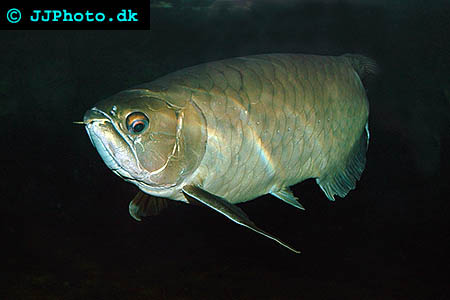
Asian Arowana - Scleropages formosus. Copyright www.jjphoto.dk
The Silver Arowana (Osteoglossum bicirrhosum) comes from the Amazon Basin. They can grow to around 48 inches in the wild, and are usually the cheapest Arowana species. Silver Arowana can be more jumpy then the other species and more than one Silver Arowana have jumped to their death in a badly covered aquarium.
Silver Arowana may take a while to adjust to non-live food. Sometimes to the brink of starvation. Feed them meaty food like, fish, crab, or Shrimp (try to avoid the salt). This Arowana Fish thrives in temperatures between 75 and 86 degrees Fahrenheit (24-30 C), and pH between 6 and 7. Young Silver Arowana should not be in a tank shorter then 36 inches/ 90 cm, and as they get older, 48 inches/ 120 cm though when your Arowana fish reaches 15 inches/ 40 cm they will need a much larger tank. These Arowana Fish can become aggressive towards similar species and should be kept alone in the aquarium tank unless it is very big. They can also be kept with larger catfish and a few other species. They are a definitely predator and will eat smaller fish. As juveniles, they may be suitable for smaller home aquarium, though with growth, they are likely to outgrow the home and become suitable only for large public aquariums.
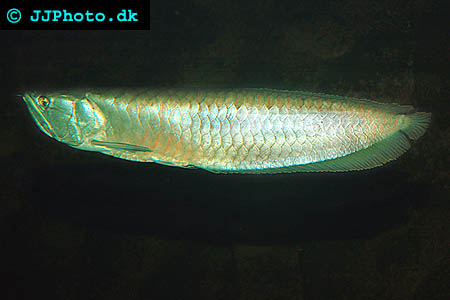
Silver Arowana - Osteoglossum bicirrhosum. Copyright www.jjphoto.dk
The Spotted Arowana (Scleropages leichardti) is mostly found from Southern Australia. They can grow to around 36 inches/ 90 cm (they do however only seldom reach this length in an aquarium), and are less sought after then the Asian Arowana. They are also called Dawson River Saratoga, Southern Saratoga, Spotted Barramundi, Australian Spotted Arowana, and Leichardti Saratoga. They tend to stay closer to the bottom than other Arowana fish species. This means that it sometimes is possible to keep them with Silver Arowana fish. As far as food, they are capable of eating most things that will fit their mouth (crickets, Hikari pellets, insects, etc). This Arowana fish species prefers a temperatures between 75 and 86 degrees Fahrenheit (24-30 C), and a pH level between 6.5 and 7.5. They may be territorial and aggressive.
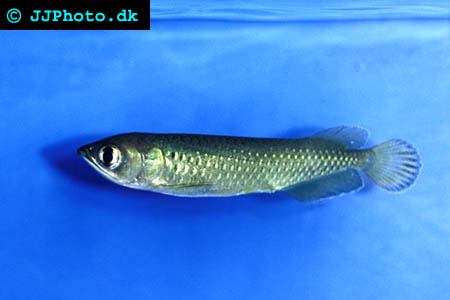
Spotted Arowana - Scleropages leichardtii. Copyright www.jjphoto.dk
The Northern Arowana (Scleropages jardini) is found mostly in Northern Australia. They can grow to around 36 inches/ 90 cm. They are also called Northern Saratoga, Jardine Saratoga, Gulf Saratoga, Australian Gold or Pearl Arowana and Jardini Saratoga. They eat similar food as the Spotted Arowana (Southern Australia), and are less likely to jump out of the tank than other species (though they might). This variety of Arowana Fish is best kept at a pH level of 6.0 - 7.5 and temperatures of 72 to 80 degrees Fahrenheit (22-27 C). While less aggressive then others, they are still predators and will likely eat anything that will fit in their mouths. They will eat Crayfish, Fish, Insects, and pellets with a little effort to get them started.
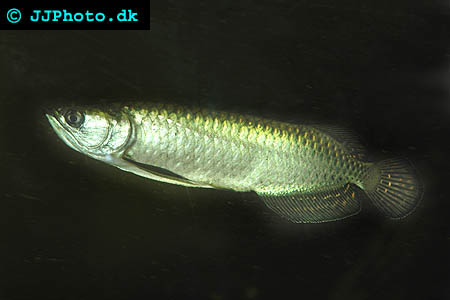
Northern Arowana - Scleropages jardinii. Copyright www.jjphoto.dk
The African Arowana (Heterotis niloticus) comes from western and central Africa. They grow up to around 40 inches/100 cm. They are more rare than other Arowana Fish species. They are predators known to eat small fish. This Arowana Fish prefers temperatures between 75 and 86 degrees Fahrenheit (24-30 C) and a pH level of 6.7 to 7.5 (7.0 preferred). They eat shrimp, fish, live worms, and insects in captivity.
The Black Arowana fish (Osteoglossum ferreirai) comes from South America in the Rio Negro basin. They grow up to around 40 inches / 100 com, though they seldom reach this length in captivity. The Black Arowana fish eat live fish, large insects, spiders, Tubifex worms, and may also eat pellets and flakes (not all specimens accept pellets and flakes). Young Arowana fish of this species tend to be delicate, though older fish tend to be more hardy. They prefer a pH level of 5-7 with 6.4 being the optimum level, and temperatures between 75 and 86 degrees Fahrenheit (24-30 C).
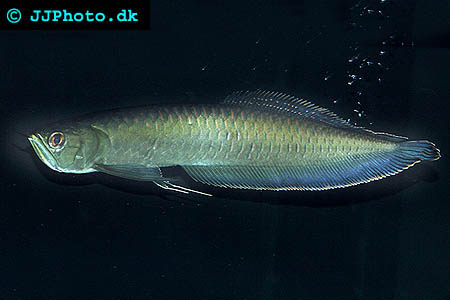
ntroduce More About Freshwater Aquarium Fish,how to animal and care for a most beautiful aquarium and relax after a hard working day You will feel more interesting when looking at them
Arowana Fish (sometimes called dragon fish) can be a great choice for those that think big. Some varieties can grow up to Four feet long (120cm). They can be feisty, though become tamer with age to the point of eating from your fingers, and not the fingers themselves. The Arowana Fish comes from somewhat primitive origins (Jurassic Age), and some varieties are nicknamed “Bony Tongued Fish”.
Arowana fish are carnivores, though will generally eat nearly anything. Young Arowana Fish may be fed frozen or live brine shrimp, black worms, and even small fish. When older, some larger fish will do. Baby Arowana Fish should be fed maybe 3 times a day, medium sized twice a day, and adults once a day, or even once every other day. Variety is important for a well balanced diet in Arowana Fish just like for most other fish.
The Arowana eating habits produce a lot of waste and you should therefore, pay extra attention to water conditions (Ammonia, Nitrite, and Nitrate) in your aquarium. Changing 25% to 33% of the water weekly is advisable, or better yet, 20% twice a week. You should maintain the pH neutral. Pay particular attention to the temperature and pH ranges suggested below on the various species, since if you have it too warm, it might cause them to age faster, look less Arowana, and even shorten their life. A to cold temperature might on the other hand kill them.
Generally, a good healthy Arowana Fish will grow to be at least 24 to 30 inches (60-75cm). Some varieties can become 48 inches (120 cm) in the wild. They may be aggressive (definitely not good community fish), and Arowana fish can sometimes be best kept alone in an aquarium. Remember that other smaller fish in the tank may become their dinner.
Arowana fish will often swim in the top of the aquarium, and are capable of jumping from the aquarium. Keep the aquarium well covered to avoid coming home to a dead pet. Silver Arowana Fish in the wild have been known to jump at insects in trees.
Arowana Fish may live for many years, and if well cared for Arowana fish may live longer than 20 years in captivity. If you keep the aquarium temperature towards the lower end, they may look young longer than they would in a higher temperaturel. Please pay particular attention to each Arowana Fish’s needs below.
The Asian Arowana or Golden Arowana (Scleropages formosus) is considered an endangered species. Care should be taken to follow the law in purchasing and transporting them. Asian Arowana fish generally can grow to about 36 inches, and are often much more expensive then the other Arowana species. These are well known and popular South East Asia where they are believed to bring luck. Feeding them healthy Guppies, Gold Fish, Frogs, or Shrimp makes a good stable diet. The temperature is best kept between 75 and 86 degrees Fahrenheit (24-30 C), and a pH level between 7.0 and 7.5 are advisable.
Arowana fish are carnivores, though will generally eat nearly anything. Young Arowana Fish may be fed frozen or live brine shrimp, black worms, and even small fish. When older, some larger fish will do. Baby Arowana Fish should be fed maybe 3 times a day, medium sized twice a day, and adults once a day, or even once every other day. Variety is important for a well balanced diet in Arowana Fish just like for most other fish.
The Arowana eating habits produce a lot of waste and you should therefore, pay extra attention to water conditions (Ammonia, Nitrite, and Nitrate) in your aquarium. Changing 25% to 33% of the water weekly is advisable, or better yet, 20% twice a week. You should maintain the pH neutral. Pay particular attention to the temperature and pH ranges suggested below on the various species, since if you have it too warm, it might cause them to age faster, look less Arowana, and even shorten their life. A to cold temperature might on the other hand kill them.
Generally, a good healthy Arowana Fish will grow to be at least 24 to 30 inches (60-75cm). Some varieties can become 48 inches (120 cm) in the wild. They may be aggressive (definitely not good community fish), and Arowana fish can sometimes be best kept alone in an aquarium. Remember that other smaller fish in the tank may become their dinner.
Arowana fish will often swim in the top of the aquarium, and are capable of jumping from the aquarium. Keep the aquarium well covered to avoid coming home to a dead pet. Silver Arowana Fish in the wild have been known to jump at insects in trees.
Arowana Fish may live for many years, and if well cared for Arowana fish may live longer than 20 years in captivity. If you keep the aquarium temperature towards the lower end, they may look young longer than they would in a higher temperaturel. Please pay particular attention to each Arowana Fish’s needs below.
The Asian Arowana or Golden Arowana (Scleropages formosus) is considered an endangered species. Care should be taken to follow the law in purchasing and transporting them. Asian Arowana fish generally can grow to about 36 inches, and are often much more expensive then the other Arowana species. These are well known and popular South East Asia where they are believed to bring luck. Feeding them healthy Guppies, Gold Fish, Frogs, or Shrimp makes a good stable diet. The temperature is best kept between 75 and 86 degrees Fahrenheit (24-30 C), and a pH level between 7.0 and 7.5 are advisable.

Asian Arowana - Scleropages formosus. Copyright www.jjphoto.dk
The Silver Arowana (Osteoglossum bicirrhosum) comes from the Amazon Basin. They can grow to around 48 inches in the wild, and are usually the cheapest Arowana species. Silver Arowana can be more jumpy then the other species and more than one Silver Arowana have jumped to their death in a badly covered aquarium.
Silver Arowana may take a while to adjust to non-live food. Sometimes to the brink of starvation. Feed them meaty food like, fish, crab, or Shrimp (try to avoid the salt). This Arowana Fish thrives in temperatures between 75 and 86 degrees Fahrenheit (24-30 C), and pH between 6 and 7. Young Silver Arowana should not be in a tank shorter then 36 inches/ 90 cm, and as they get older, 48 inches/ 120 cm though when your Arowana fish reaches 15 inches/ 40 cm they will need a much larger tank. These Arowana Fish can become aggressive towards similar species and should be kept alone in the aquarium tank unless it is very big. They can also be kept with larger catfish and a few other species. They are a definitely predator and will eat smaller fish. As juveniles, they may be suitable for smaller home aquarium, though with growth, they are likely to outgrow the home and become suitable only for large public aquariums.

Silver Arowana - Osteoglossum bicirrhosum. Copyright www.jjphoto.dk
The Spotted Arowana (Scleropages leichardti) is mostly found from Southern Australia. They can grow to around 36 inches/ 90 cm (they do however only seldom reach this length in an aquarium), and are less sought after then the Asian Arowana. They are also called Dawson River Saratoga, Southern Saratoga, Spotted Barramundi, Australian Spotted Arowana, and Leichardti Saratoga. They tend to stay closer to the bottom than other Arowana fish species. This means that it sometimes is possible to keep them with Silver Arowana fish. As far as food, they are capable of eating most things that will fit their mouth (crickets, Hikari pellets, insects, etc). This Arowana fish species prefers a temperatures between 75 and 86 degrees Fahrenheit (24-30 C), and a pH level between 6.5 and 7.5. They may be territorial and aggressive.

Spotted Arowana - Scleropages leichardtii. Copyright www.jjphoto.dk
The Northern Arowana (Scleropages jardini) is found mostly in Northern Australia. They can grow to around 36 inches/ 90 cm. They are also called Northern Saratoga, Jardine Saratoga, Gulf Saratoga, Australian Gold or Pearl Arowana and Jardini Saratoga. They eat similar food as the Spotted Arowana (Southern Australia), and are less likely to jump out of the tank than other species (though they might). This variety of Arowana Fish is best kept at a pH level of 6.0 - 7.5 and temperatures of 72 to 80 degrees Fahrenheit (22-27 C). While less aggressive then others, they are still predators and will likely eat anything that will fit in their mouths. They will eat Crayfish, Fish, Insects, and pellets with a little effort to get them started.

Northern Arowana - Scleropages jardinii. Copyright www.jjphoto.dk
The African Arowana (Heterotis niloticus) comes from western and central Africa. They grow up to around 40 inches/100 cm. They are more rare than other Arowana Fish species. They are predators known to eat small fish. This Arowana Fish prefers temperatures between 75 and 86 degrees Fahrenheit (24-30 C) and a pH level of 6.7 to 7.5 (7.0 preferred). They eat shrimp, fish, live worms, and insects in captivity.
The Black Arowana fish (Osteoglossum ferreirai) comes from South America in the Rio Negro basin. They grow up to around 40 inches / 100 com, though they seldom reach this length in captivity. The Black Arowana fish eat live fish, large insects, spiders, Tubifex worms, and may also eat pellets and flakes (not all specimens accept pellets and flakes). Young Arowana fish of this species tend to be delicate, though older fish tend to be more hardy. They prefer a pH level of 5-7 with 6.4 being the optimum level, and temperatures between 75 and 86 degrees Fahrenheit (24-30 C).

Thứ Hai, 25 tháng 5, 2015
Freshwater Aquarium Fish_flowerhorns spots
Freshwater Aquarium Fish_flowerhorns spots

History
Thus far very few or no scientific documentation studied about the genetics history of flowerhorn cichlids. They are known as hybrid species whose parents were believed to be South American cichlids. Some hobbyists may agree that flowerhorns were developed or bred by a group of Malaysians in the late 1900's, whereas others may not necessarily believe so. Theoretically, flowerhorns were the result of cross breeding between different types of South American cichlids. The theory of cross breeding were to combine the good strains from each parents, i.e., body shapes, humps, color, etc. Although not all breeders were successfully crossbred flowerhorns, many of them had produced some very rare strains. Initially, the breeding techniques and the parents of flowerhorns were kept secret due to business purposes.
For quite a long time, flowerhorns were believed to be fish of luck. Very few of them developed Chinese characters on the humps and sides. Some people believe that underneath the chin of flowerhorns represents a bank of treasure, which bring luck to the owners. Different people had different believe on flowerhorns. In addition to their beauty, the belief in luck on the flowerhorns made them very expensive in the late 1900's and early 2000. Most folowerhorn owners during that time were mostly upper class, wealthy families, and small entrepreneurs. That was one flowerhorn could cost up to $1,00.00 or more. Therefore, many breeders take that opportunity to build flowerhorn farms and ran small business by selling flowerhorns.
In the past several years, flowerhorns were brought into the United States and were popular among Asian Americans. As the popularity of flowerhorns caught the interest of other fish hobbyists in America, small businesses, i.e., local fish stores developed. These stores imported flowerhorns to the United States and sold locally. As the numbers of this business increased, people began to see flowerhorns sold on eBay and other online stores.
Today flowerhorns are not as expensive as in the late 1900's due to a few reasons: (1) many breeders entered the market and resulted in increasing the number of flowerhorns, (2) most flowerhorn hobbyists were successfully bred flowerhorns on their own, and (3) flowerhorn are easy to export or import from country to country within 48 hours or overnight. Now most people raise flowerhorns for a hobby instead of the belief that flowerhorns are fish of luck.
For quite a long time, flowerhorns were believed to be fish of luck. Very few of them developed Chinese characters on the humps and sides. Some people believe that underneath the chin of flowerhorns represents a bank of treasure, which bring luck to the owners. Different people had different believe on flowerhorns. In addition to their beauty, the belief in luck on the flowerhorns made them very expensive in the late 1900's and early 2000. Most folowerhorn owners during that time were mostly upper class, wealthy families, and small entrepreneurs. That was one flowerhorn could cost up to $1,00.00 or more. Therefore, many breeders take that opportunity to build flowerhorn farms and ran small business by selling flowerhorns.
In the past several years, flowerhorns were brought into the United States and were popular among Asian Americans. As the popularity of flowerhorns caught the interest of other fish hobbyists in America, small businesses, i.e., local fish stores developed. These stores imported flowerhorns to the United States and sold locally. As the numbers of this business increased, people began to see flowerhorns sold on eBay and other online stores.
Today flowerhorns are not as expensive as in the late 1900's due to a few reasons: (1) many breeders entered the market and resulted in increasing the number of flowerhorns, (2) most flowerhorn hobbyists were successfully bred flowerhorns on their own, and (3) flowerhorn are easy to export or import from country to country within 48 hours or overnight. Now most people raise flowerhorns for a hobby instead of the belief that flowerhorns are fish of luck.
Flowerhorns are most popular among young people between the ages of 15 - 35 years old. Most flowerhorn hobbyists are males. Recently, very few females and older males began to raise flowerhorns.
Why is it called Flowerhorn?
 "Flowerhorn" is a common name for this species. They received the name "Flowerhorn" from their physical appearance. The word "Flower" came from the two black spots on both sides of their heads or humps, as demonstrated on the picture on the right. The word "horn" came from the hump. Most babies (fries) or young flowerhorns do not have a hump. As they grow adult, they will develop a hump and the two black spots on the side of the head spread out look like two-dimensional flowers. Therefore, combining the two words came with the name "Flowerhorn." However, not all flowerhorns have humps and flowers. Some flowerhorns have very big humps; some have small humps, and other have almost no hump. Like wise, some have flowers whereas the others do not. Nevertheless, they fall into same category—Flowerhorns.
"Flowerhorn" is a common name for this species. They received the name "Flowerhorn" from their physical appearance. The word "Flower" came from the two black spots on both sides of their heads or humps, as demonstrated on the picture on the right. The word "horn" came from the hump. Most babies (fries) or young flowerhorns do not have a hump. As they grow adult, they will develop a hump and the two black spots on the side of the head spread out look like two-dimensional flowers. Therefore, combining the two words came with the name "Flowerhorn." However, not all flowerhorns have humps and flowers. Some flowerhorns have very big humps; some have small humps, and other have almost no hump. Like wise, some have flowers whereas the others do not. Nevertheless, they fall into same category—Flowerhorns.
Introduce More About Freshwater Aquarium Fish,how to animal and care for a most beautiful aquarium and relax after a hard working day You will feel more interesting when looking at them
How to Care for Red Dragon Flowerhorns
Simple Tips for Enhancing Red Dragon Flowerhorns
The red dragon flowerhorn is one of the very first Lou Hans I kept. As with other flowerhorns belonging to the Zen Zhou category, the red dragon is unbelievably very easy to enhance and care for. If you are a newbie to this hobby, I suggest keeping this strain or any strain belonging to the Zen Zhou category.
In this post, I will discuss with you everything you need to know on how to care for red dragon flowerhorns. Even if you have very limited experience keeping fishes, I guarantee that by following the tips below, you will do just fine in keeping these hardy cichlids.
Choosing the Right Fish
Health, above anything else, should be your primary consideration when choosing a red dragon. Fish should be free of defects, have no visible signs of disease, and should swim just fine.
When it comes to buying flowerhorns, it’s better to buy a better quality fish even if the price is a bit higher. In my experience, it’s almost always better buying a single high quality fish at premium price than buying a few low quality ones at bargain price with the hope that they will turn out beautiful once enhanced. Check out my other post for a more detailed discussion about the traits, pricing, and origin of the red dragon flowerhorn.
Preparing the Tank
A 50-gallon tank would suffice for most red dragons aging two years or less. In fact, these may serve them just enough for their entire lifetime. Unlike many classic Lou Hans, new strains normally don’t grow as large. However, you should still observe the growth rate of your fish as it’s not uncommon for many new red dragons to grow to a fuller size. If you think your fish is already having trouble moving around its tank, you definitely should get it a much larger tank.
If you prefer buying a juvenile fish that you could rear until they achieve their best potential, I suggest using a 50-gallon tank until they reach 6-8 inches in size. If you think your fish is still growing, buy it a larger tank. A 70-gallon tank is the smallest in this case. Or you could just use a 70-gallon tank right away. With these fast-growing cichlids, bigger tanks are always better. Read more about this topic on our guide on flowerhorn tank sizes.
Comprehensive Feeding Guide
The red dragon flowerhorn would eagerly consume any fish food designed for cichlids and they would just do fine. If you however want to enhance your pet to achieve its full potentials, provide it with fish food that are rich in Astaxanthin, preferably those derived from natural ingredients like krill. Personally, I stay away from synthetic astaxanthin. In my experience, they make fish develop redness much faster but there effects are not as long-lasting and as vibrant as with fish food containing natural enhancers.
At their growth years provide them with high protein fish food, but slowly shift to those containing more vegetable matter as they grow older. Personally, I believe that this will help you fish live longer. Always check that they are not very fat and overfed as this is the biggest reason for poor health. The growth rate of the red dragon flowerhorn typically starts to decline as they reach six inches. I think that’s the right time to SLOWLY shift to fish food containing less protein and more fiber and spirulina. Read more on food for flowerhorn head growth.
Keeping Your Fish Healthy
Flowerhorns are voracious eaters so it’s expected that they would produce a lot of waste. Keep you fish healthy by following a strict feeding routine. Again, NEVER overfeed.
Religiously follow a water change routine. Red dragons unlike many Kamfa are not as susceptible to the bad effects of water change and may in fact benefit from it more if done frequently. You don’t have to remove the fish from the tank. Just siphon waste along with 30% tank water and replace with aged water. Do this every week or two.
Provide your fish with properly lighting as well. Check out our guide on flowerhorn lighting
Provide your fish with properly lighting as well. Check out our guide on flowerhorn lighting
Đăng ký:
Bài đăng (Atom)
